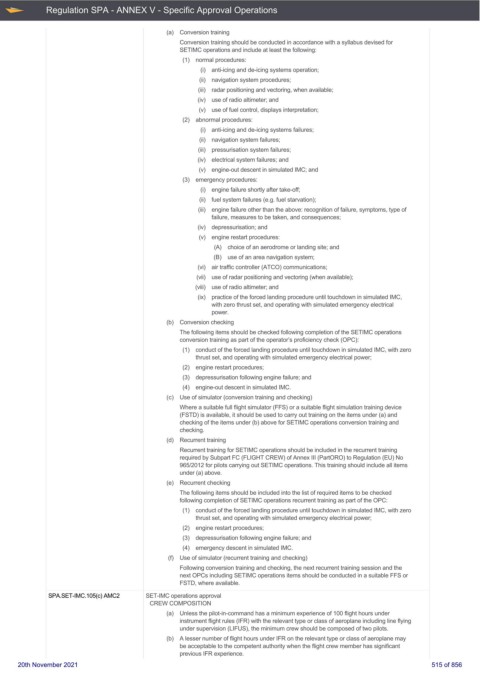Page 515 - UK Air Operations Regulations 201121
P. 515
~
~ Regulation SPA - ANNEX V - Specific Approval Operations Centrik
(a) Conversion training
Conversion training should be conducted in accordance with a syllabus devised for
SETIMC operations and include at least the following:
(1) normal procedures:
(i) anti-icing and de-icing systems operation;
(ii) navigation system procedures;
(iii) radar positioning and vectoring, when available;
(iv) use of radio altimeter; and
(v) use of fuel control, displays interpretation;
(2) abnormal procedures:
(i) anti-icing and de-icing systems failures;
(ii) navigation system failures;
(iii) pressurisation system failures;
(iv) electrical system failures; and
(v) engine-out descent in simulated IMC; and
(3) emergency procedures:
(i) engine failure shortly after take-off;
(ii) fuel system failures (e.g. fuel starvation);
(iii) engine failure other than the above: recognition of failure, symptoms, type of
failure, measures to be taken, and consequences;
(iv) depressurisation; and
(v) engine restart procedures:
(A) choice of an aerodrome or landing site; and
(B) use of an area navigation system;
(vi) air traffic controller (ATCO) communications;
(vii) use of radar positioning and vectoring (when available);
(viii) use of radio altimeter; and
(ix) practice of the forced landing procedure until touchdown in simulated IMC,
with zero thrust set, and operating with simulated emergency electrical
power.
(b) Conversion checking
The following items should be checked following completion of the SETIMC operations
conversion training as part of the operator’s proficiency check (OPC):
(1) conduct of the forced landing procedure until touchdown in simulated IMC, with zero
thrust set, and operating with simulated emergency electrical power;
(2) engine restart procedures;
(3) depressurisation following engine failure; and
(4) engine-out descent in simulated IMC.
(c) Use of simulator (conversion training and checking)
Where a suitable full flight simulator (FFS) or a suitable flight simulation training device
(FSTD) is available, it should be used to carry out training on the items under (a) and
checking of the items under (b) above for SETIMC operations conversion training and
checking.
(d) Recurrent training
Recurrent training for SETIMC operations should be included in the recurrent training
required by Subpart FC (FLIGHT CREW) of Annex III (PartORO) to Regulation (EU) No
965/2012 for pilots carrying out SETIMC operations. This training should include all items
under (a) above.
(e) Recurrent checking
The following items should be included into the list of required items to be checked
following completion of SETIMC operations recurrent training as part of the OPC:
(1) conduct of the forced landing procedure until touchdown in simulated IMC, with zero
thrust set, and operating with simulated emergency electrical power;
(2) engine restart procedures;
(3) depressurisation following engine failure; and
(4) emergency descent in simulated IMC.
(f) Use of simulator (recurrent training and checking)
Following conversion training and checking, the next recurrent training session and the
next OPCs including SETIMC operations items should be conducted in a suitable FFS or
FSTD, where available.
SPA.SET-IMC.105(c) AMC2 SET-IMC operations approval
CREW COMPOSITION
(a) Unless the pilot-in-command has a minimum experience of 100 flight hours under
instrument flight rules (IFR) with the relevant type or class of aeroplane including line flying
under supervision (LIFUS), the minimum crew should be composed of two pilots.
(b) A lesser number of flight hours under IFR on the relevant type or class of aeroplane may
be acceptable to the competent authority when the flight crew member has significant
previous IFR experience.
20th November 2021 515 of 856

